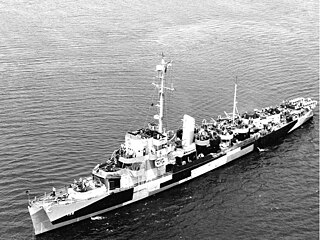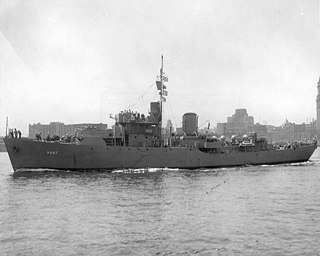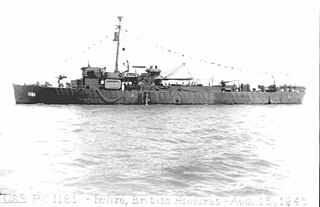
USS Big Horn (AO-45/WAO-124/IX-207) was a Q-ship of the United States Navy named for the Bighorn River of Wyoming and Montana.

USS Prudent (PG–96), originally ordered as HMS Privet, was an Action-class patrol gunboat in the United States Navy.

USS Plymouth (PG-57), a patrol gunboat, was the fourth ship of the United States Navy to be named for Plymouth, Massachusetts, a town founded by the Pilgrims in 1620 on Plymouth Bay, about 35 miles southeast of Boston.

USS Peterson (DE–152) was an Edsall class destroyer escort, the first United States Navy ship so named. This ship was named for Chief Water Tender Oscar V. Peterson (1899–1942), who was awarded the Medal of Honor posthumously for his actions during the Battle of the Coral Sea.

USS Hayter (DE-212/APD-80) was a Buckley-class destroyer escort in service with the United States Navy from 1943 to 1946. In 1967, she was transferred to South Korea where she served as ROKS Jonnam until 1986.

USS Spangenberg (DE/DER-223), a Buckley-class destroyer escort of the United States Navy, was named in honor of Gunner's Mate Kenneth J. Spangenberg (1922–1942), who died as a result of wounds suffered during the Naval Battle of Guadalcanal, while serving aboard the heavy cruiser San Francisco (CA-38). He was posthumously awarded the Navy Cross.

USS Alexander J. Luke (DE/DER-577), a Buckley-class destroyer escort of the United States Navy, was named in honor of Sergeant Alexander J. Luke (1916–1942), who was killed in action during the attack on Tulagi on 6 August 1942. He was posthumously awarded the Silver Star.

USS Andres (DE-45) was an Evarts-class destroyer escort constructed for the United States Navy during World War II. Sent off to the dangerous waters of the North Atlantic Ocean during the Battle of the Atlantic to protect convoys and other ships from Nazi Germany's Kriegsmarine U-boats and fighter aircraft, Andres performed escort and anti-submarine operations.

USS Amick (DE-168) was a Cannon-class destroyer escort built for the United States Navy during World War II. She served in the Atlantic Ocean and then the Pacific Ocean and provided escort service against submarine and air attack for Navy vessels and convoys.

USS Jacob Jones (DE-130) was an Edsall-class destroyer escort built for the U.S. Navy during World War II. She served in the Atlantic Ocean and provided destroyer escort service against submarine and air attack for Navy vessels and convoys.

USS Blair (DE-147) was an Edsall-class destroyer escort in service with the United States Navy from 1943 to 1946 and from 1951 to 1960. She was scrapped in 1974. Blair was named in honor of Chief Machinist's Mate Eugene Blair, who was awarded the Silver Star posthumously for his brave actions when his ship was attacked and bombed by Japanese planes near Port Darwin, Australia, in mid-February 1942.

USS Tomich (DE-242) was an Edsall-class destroyer escort in service with the United States Navy from 1943 to 1946. She was scrapped in 1974.

USS Otterstetter (DE-244) was an Edsall-class destroyer escort built for the U.S. Navy during World War II. She served in the Atlantic Ocean the Pacific Ocean and provided destroyer escort protection against submarine and air attack for Navy vessels and convoys.

USS Alacrity (PG-87) was an Action-class patrol boat acquired by the United States Navy for the task of patrolling American coastal waters during World War II.

USS Surprise (PG-63), the fourth American naval ship of the name, was a Temptress-class patrol gunboat during World War II. She was built as the British Flower-class corvette HMS Heliotrope, and was in service with the Royal Navy during the first years of the Battle of the Atlantic. She was loaned to and operated by the United States Navy from 1942 to 1945. After World War II, she was sold as a merchant vessel and ended her life in the Chinese navy as Lin I.

USS PC-1181 was a PC-461-class submarine chaser built for the United States Navy during World War II. She was later renamed Wildwood (PC-1181) but never saw active service under that name.

USS Asheville (PF-1) was an Asheville-class patrol frigate of the United States Navy that served during World War II. She was laid down on 10 March 1942 by Canadian Vickers Ltd. in Montreal, Quebec, Canada as the River-class frigate HMS Adur (K296) to serve in the British Royal Navy. She was launched on 22 August 1942 but due to a lack of American vessels for convoy protection she was transferred to the United States Navy prior to completion. On 1 December 1942, she was commissioned in Montreal as USS Asheville (PG-101), a patrol gunboat. She was reclassified PF-1 on 15 April 1943.
USS Action (PG-86) was the lead ship of the Action-class patrol boats acquired by the United States Navy for the task of patrolling American coastal waters during World War II. She is the only ship to bear this name.

USS Might (PG-94) was laid down as Canadian corvette CN-312 by Morton Engineering and Drydock Co., Ltd., Quebec, Canada, on 28 November 1941 and launched as HMS Musk on 15 July 1942. The ship was transferred to the United States Navy on 20 July 1942, renamed Might on 14 August 1942, and commissioned at Quebec on 22 December 1942.
USS Pert (PG-95), the second United States Navy ship of that name, was one of eight Canadian-built corvettes turned over to the U.S. Navy for operation by the United States Coast Guard. She was laid down by Morton Engineering and Dry Dock Co., Ltd., Quebec, Canada, 22 July 1942; launched 27 November 1942; and commissioned at Quebec 23 July 1943.

















